This website is supported by its readers. If you click one of my links I may earn a commission. I am also a participant in the Amazon affiliates program and I will also earn a commission from qualified purchases.
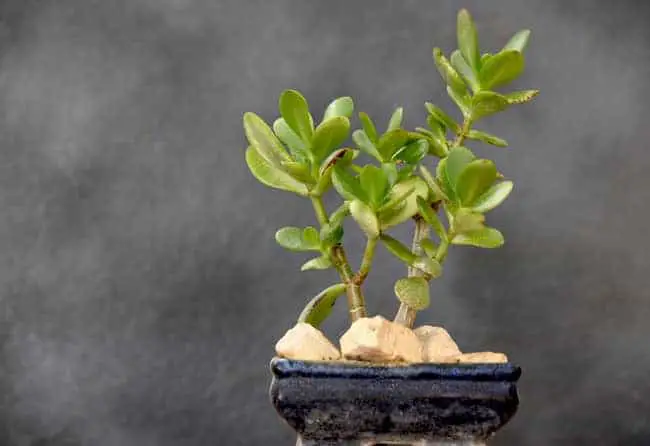
One of the most common species used for bonsai that is shooting up in popularity is jade bonsai. Jade bonsai is an incredibly versatile tropical succulent and is often viewed as the perfect species to keep indoors. So how exactly do you grow jade bonsai?
To grow jade bonsai, take a cutting of a jade branch. Keep in a glass with two inches of water until roots start to appear. Then apply root hormone and plant in a bonsai soil mix. Keep in a propagator and ease into sunlight over 6 weeks and your jade bonsai will start to grow.
So is growing jade bonsai difficult? And what is the exact step-by-step method you need to follow to grow jade bonsai? Keep reading to find out more!
Just a quick heads up, over the past three years of running Plantpaladin, hundreds of people have asked for product recommendations. As such, You can find my favorite indoor bonsai tree here (link takes you to Bonsaiboy), my favorite outdoor bonsai tree (link takes you to Bonsaiboy), or have a look at all the products I recommend here.
How to grow jade bonsai
With its round water-filled leaves and branches, beginner-friendly nature, and relatively inexpensive price, it’s no surprise that jade bonsai are amongst the best-selling bonsai trees in the marketplace right now.
What’s even better is that these trees are relatively simple to grow – should you decide to grow from scratch.
That being said, like all bonsai tree species, there are some steps specific to jade trees you need to keep in mind should you decide to grow these from scratch.
The following steps should be followed:
- Ensure it’s the right time of year
- Decide how big you want your jade bonsai to grow
- Decide on the look of your jade bonsai
- Store-bought trees vs cuttings or seedlings
- Make the cutting at a 45-degree angle
- Remove any excess leaves
- Prepare your pots
- Add your soil mix
- Prepare to plant your jade bonsai cutting or seeds
- Add rooting powder
- Plant your jade cuttings in the soil pot
- Add root hormone
- Keep in a propagator for 2 to 4 weeks
- Get sunlight into your jade bonsai
- Water regularly
- Prune after a year
- Repeat the process
- Repot after a few years
Jade Bonsai tree Requirements | Explained |
Water | Once per day in the spring-summer or if kept indoors. |
Sunlight | 4 hours of direct sunlight in the summer. LED grow light can also be used. |
Temperature | Between 40 degrees F and 100 degrees F |
Fertilizer | Once per month in the spring and summer - avoid in fall and winter. |
Repotting | Once every 2 to 3 years in the first 10 years. You can then report once every 5 years. Undertake to repot in spring. |
Placement | Mainly indoors, unless you live in a hot climate. |
Wire type | Both copper and aluminum wire can be used. |
Time to grow from scratch into maturity | 10 to 15 years to reach full maturity |
Potting soil | An inorganic Akdama, volcanic ash soil mix works best. |
Growth type | Slow growing, averaging 3-5 inches of growth per year. |
Size | Average store-bought trees are size is one or two-handed bonsai trees - 3 to 10 inches in size, 2 to 8 inches wide |
Lifespan | 50 to 150 years |
Fruit | None |
Let’s explore these in more detail.
Ensure it’s the right time of year
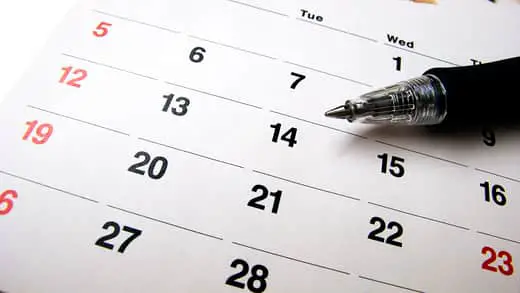
A lot of people make the mistake of growing jade bonsai or buying their tree from the store or planting it right away.
Before any of these methods are even remotely considered you need to pay attention to the most crucial aspect of bonsai keeping.
The climate.
Whilst jade bonsai trees are tropical bonsai trees and ideal for keeping indoors, they (like all bonsai trees) will require a lot of sunlight to grow and propagate correctly.
As such, planting or growing a bonsai or starting this process during the fall or winter will result in your tree not growing or – in a worst-case scenario, can prove to be fatal to your tree.
As such, only plant or start the growing process in early spring.
I found that the last few weeks of March tend to work best.
Decide how big you want your jade bonsai to grow
Another crucial step that is missed out way too often in my opinion.
Jade bonsai trees will typically grow around 2 to 5 inches per year and so are relatively slow-growing trees.
As such, the amount of time it will take to grow a jade bonsai species to a medium-sized two-hand bonsai can take 4 to 6 years.
Now bonsai size classification is a topic all unto itself so to help I’ve written a post about it here.
Hopefully, however, the table below will explain how large a jade bonsai tree gets and how long it takes to grow to different size classifications.
| Classification | Size inches | Size Centimeters | Hand size | General size | How long jade bonsai will take to grow to this size |
| Keshitsubo | 1 to 3 inches | 3 to 8 centimeters | Fingertip | Tiny | 6 months |
| Shito | 2 to 4 inches | 5 to 10 centimeters | One-hand | Tiny | 8 months |
| Mame | 2 to 6 inches | 5 to 15 centimeters | One-hand | Small | 1 year |
| Chohin | 5 to 8 inches | 13 to 20 centimeters | One-hand | Small | 1 ½ year |
| Kumono | 6 to 10 inches | 15 to 25 centimeters | One-hand | Small | 2 years |
| Katade-mochi | 10 to 18 inches | 25 to 46 centimeters | Two-hand | Medium | 3 ½ years |
| Chiu or Chumono | 16 to 36 inches | 41 to 91 centimeters | Two-hand | Medium | 6 years |
| Dai or Omono | 30 to 48 inches | 76 to 122 centimeters | Four-hand | Large | 8 ½ years |
| Hachi-uye | 40 to 60 inches | 102 to 152 centimeters | Six-hand | Large | 9 ½ years |
| Imperial | 60 to 80 inches | 152 to 203 centimeters | Eight-hand | Large | 13 ½ years |
Jade bonsai shape
On top of this, should you decide to want to shape your bonsai from scratch using techniques such as growing out a sacrifice bonsai branch – then the amount of time your jade bonsai will grow will take even longer.
Should you be patient, growing a bonsai from scratch will often be the best option – after all, smaller-sized bonsai will typically work best indoors.
If however, you want a large jade bonsai full of different styles, creativity, and deadwood techniques such as jin or sabamiki, you might want to opt for a pre-bought tree that will be larger in size or a bonsai tree species that grows faster.
To give you an idea of how fast a jade bonsai grows compared to other bonsai species the table below should help.
| Bonsai species | Growth type | Average growth per year |
| Chinese Elm | Fast | 12 to 36 inches |
| Juniper | Moderate | 5 to 12 inches |
| Jade | Slow | 2 to 5 inches |
| Maple | Fast | 12 to 36 inches |
| Fukien Tea | Slow | 2 to 5 inches |
| Ficus | Fast | 12 to 36 inches |
| Wisteria | Slow | 2 to 5 inches |
| Cotoneaster | Moderate | 5 to 12 inches |
| Pine (most varieties) | Fast | 12 to 36 inches |
| Azalea | Slow | 2 to 5 inches |
Decide on the look of your jade bonsai
The final bit of prep work you will need to do is just draw out a rough outline on how you want your jade bonsai to look.
Whilst this can be changed over time as your bonsai grows, I find that in the first year or two having a rough idea of all the bends in the tree or how large you want the branches to be relative to each other will significantly help when it comes to wiring your tree further on down the line.
I find then doing something as simple as drawing up a quick rough design on some scrap paper can work well.
Store-bought trees vs cuttings or seedlings
The reason I wanted you to follow the above steps is that it is going to make the next steps a lot easier.
Now you know the rough design and size you want your bonsai tree to be as well as the amount of time you can dedicate to keeping your jade bonsai, you can then decide on if you want a premade store-bought tree or grow your tree from a cutting or seedling.
Getting a store-bought tree that is 15 to 20 years old will save you a lot of time and work and allow you to start the styling process fairly quickly – you just need to follow the right reporting and aftercare advice and you should be good to go.
Seedlings, however, whilst more work, will teach you a lot about growing bonsai trees and make you a better enthusiast – in my opinion making the experience a lot more rewarding.
A lot of you will be interested in growing your bonsai tree from seedlings or cuttings which is what the rest of the steps in this post should help you with.
Choose the right seedlings or cuttings
To grow your jade bonsai tree from scratch, you need to start by investing in the right seedlings or cuttings.
Bonsai seeds are very commonly available from any good bonsai specialist.
Cuttings on the other hand require a little more work.
Ideally, you want to use a cutting that is lower down the tree and directly connected to the trunk so primary branches usually work best.
The thicker the cutting, the better this will usually be, having a cutting that is also a few inches long will make it more likely to propagate than larger tree cuttings.
For best results then, use a primary branch cutting that is about 4 to 10 inches long and about half an inch to 1 inch wide to grow a jade bonsai.
Make the cutting at a 45-degree angle
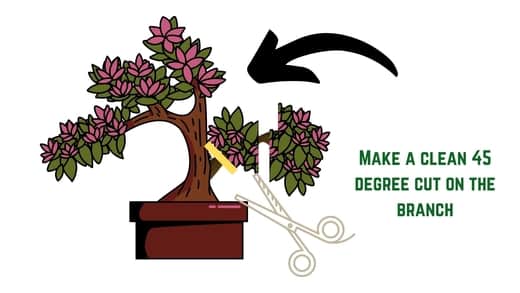
Now the fun begins.
If you have decided to use a branch cutting then cut the primary branch at a 45-degree angle.
To do this then, use a pair of bonsai shear or scissors and make one clean sharp cut to remove the primary branch cutting.
I would ensure that the cutting is made a few centimeters away from the main trunk of your existing bonsai to not damage it.
Remove any excess leaves
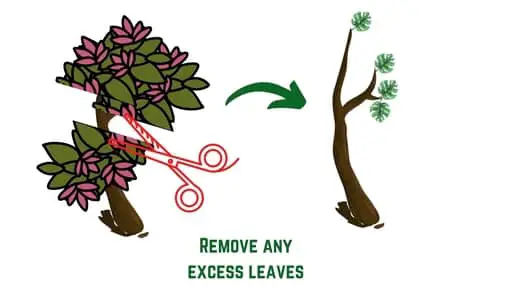
If you are planting a seedling you can skip right ahead but if you have your cutting the next thing you need to do before planting it is to remove any excess leaves or secondary branches from your cutting.
The leaves of a jade plant, like all plants, are used for the photosynthesis process.
As such, this can take a lot of effort from your tree to complete, especially as your cutting will be in a weakened state due to just being cut.
As such, use a shape pair of scissors and remove any excess leaves and branches from your cutting.
I would however leave a few leaves to ensure your cutting can generate some photosynthesis.
Prepare your pots
Now your bonsai cuttings and seedlings are prepared to be planted, then the next step is to prepare the pot that we will keep them in.
Whilst bonsai tree pots are fantastic at drainage ( albeit whilst being slightly expensive) a lot of these are not the right size for new cuttings or seedlings.
I found then that the best option specifically for cutting and seedlings would be to invest in a yogurt pot like the one below.

You will however need to add holes to the bottom of your pot.
This works best when using either a carving knife or sharp pair of scissors.
The number of holes you will need in the base of your pot will depend on the size of tree you will be looking to grow (hence why we went through this step earlier)
The table below again should help with the number of holes you will require:
| Classification | Size inches | Number of penny-sized holes | Number of pencil-sized holes |
| Keshitsubo | 1 to 3 inches | 1-2 | 0 |
| Shito | 2 to 4 inches | 1-2 | 0 |
| Mame | 2 to 6 inches | 2 | 2 |
| Chohin | 5 to 8 inches | 2 | 2 |
| Kumono | 6 to 10 inches | 2 | 2 |
| Katade-mochi | 10 to 18 inches | 2 | 3 |
| Chiu or Chumono | 16 to 36 inches | 2 | 4 |
| Dai or Omono | 30 to 48 inches | 3 | 6 |
| Hachi-uye | 40 to 60 inches | 4 | 8 |
| Imperial | 60 to 80 inches | 6 | 8 |
I’d also recommend adding a mesh once your holes have been completed on the top of your holes.
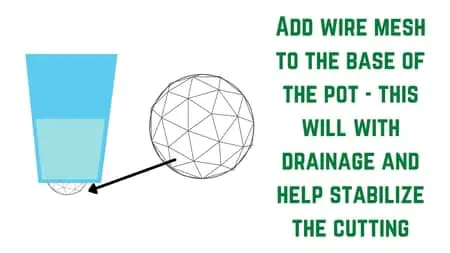
This will allow water to flow through, prevent insects from crawling up through the holes but also allow you to hold your cutting in place which we will cover later on.
Add your soil mix
Like all bonsai trees, getting the right potting soil is essential to the health of your tree.
Bonsai soil needs to provide enough aeration, hold on to water but also have fantastic drainage.
Now whilst jade trees are tropical succulents that do a good job at holding on to water, you must have a soil mix that provides a good amount of aeration.
For my money, there is no better option than an inorganic soil mix containing akadama, volcanic ash rock, and pumice.
A good organic soil alternative would be to use cactus soil which you can find out more about here.
How to add soil to your pot.
To add soil to your bonsai pot then, fill your pot until it is at least 3 inches deep with your soil mix.
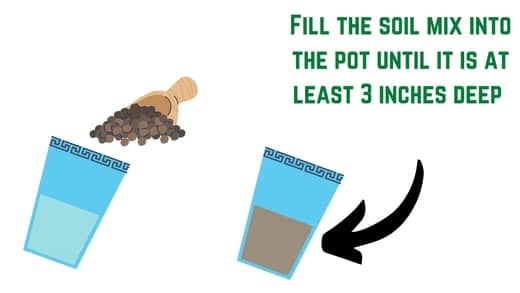
Smaller cutting less than five inches can get away with only 2 inches of soil but aim for 3 inches for best results.
At this stage, it’s important to not pack the soil too tightly as we will need to add copper wire to the base of the pot to hold the cutting in place.
Prepare to plant your jade bonsai cutting or seeds
The next step to growing a jade bonsai will be to plant your seed or cuttings in the pot.
Planting a jade bonsai seed/seedlings
Planting the seed or seedling is fairly straightforward.
Simply make a dip with one of your fingers in the center of your bonsai soil.
Place your bonsai seed, cover with more soil, and then water.
After a few days, the seed will start to sprout roots.
Seedings are seeds that have already started sprouting and so the process is the same – just ensure you are more careful when you place your seedling in the soil.
Preparing a jade bonsai cutting
Now if you have used a jade branch cutting, this is going to be a little more complicated as you have to prep your cutting for the soil.
To do this, get a sharp carving knife or scissors and carve/score a perimeter about 2cm ( or one inch) from the base of your cutting.
This scored line should be about 1mm deep- this line is important as when we remove the bark and cambium it won’t be removed from above this point.

Then using a carving knife peel back the bark and cambium (aka the green bits underneath the bark) until you hit the white inner wood from the bottom 2cm (or one inch) from the cuttings
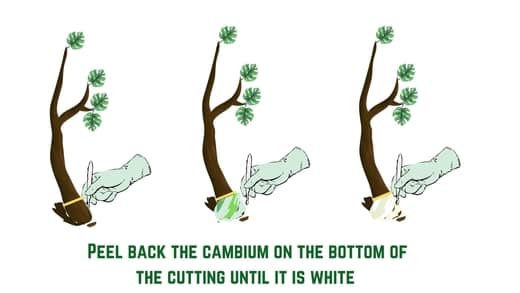
You should then be left with a cutting that has a white tip at the bottom of it.
This process is done to, ensure your jade cutting has a better chance of propagating roots
Add rooting powder
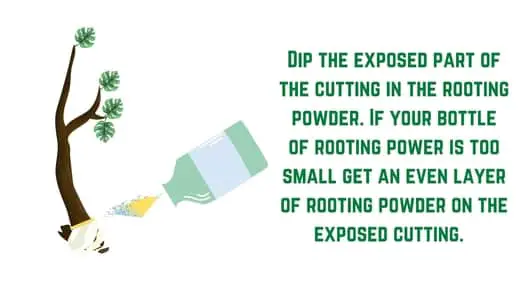
Now the root of your bonsai cutting is exposed (the white inner wood) to increase your cutting’s chances of growing and sprouting you then need to apply rooting powder.
The rooting powder contains IBA which specifically helps bonsai trees sprout new roots.
Aim to dip the white inner wood of your tree in rooting powder 3-4 times ensuring the bottom 2cm are completely covered.
Plant your jade cuttings in the soil pot
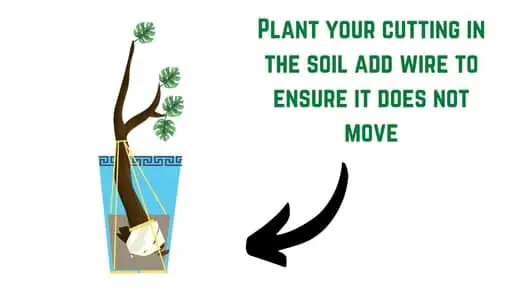
Next, we need to plant the cutting in the soil.
However, before you just cover it in the soil we need to make sure that our cutting does not move.
To do this, ensure that your soil mix is packed as tightly as possible to the cutting so it does not move.
I’d recommend using a stick (chopsticks work well for this) to poke the soil and get rid of any excess air bubbles.
Then use copper or plastic or copper wire and loop this through the mesh we placed at the base of the pot.
This will hold the jade bonsai in place, preventing it from moving around during the crucial first few weeks.
Add root hormone
Whilst this step is skippable I would recommend following it if this is the first time you’ve tried to grow jade bonsai from a cutting.
To use, get a flat tray and fill it with water – this tray should be deep enough to cover the drainage holes and mesh at the base of your pot.
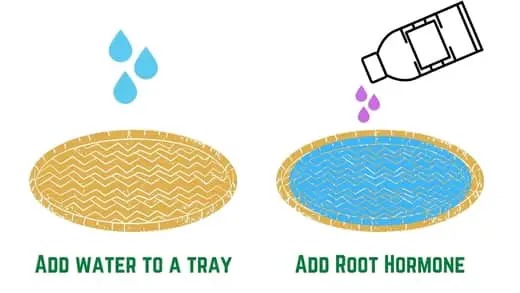
Then apply 3 to 4 drops of root hormone in the water to create a root hormone solution.
Finish by placing your pot on the tray.
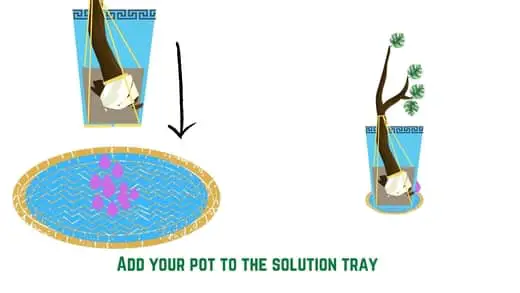
Ensure that you change the water every few days in the first two weeks to avoid your roots getting root trot.
Keep in a propagator for 2 to 4 weeks
This step is also skippable but I found that keeping newly planted jade cuttings or seedlings in a propagator drastically increased their chances of taking to the new soil.
A propagator allows you to manage the temperature, light requirements, and moisture levels for your jade bonsai.
Ideally, you want to keep your cutting or seedling in until it starts to generate two or three new leaves where you can then take it out and let it grow by itself – I find this can happen either after a few days or can be as long as a few weeks so be sure to check on your bonsai regularly.
Get sunlight into your jade bonsai
Once your jade bonsai has started to sprout you can take it out of the propagator and give it some sunlight.
Whilst these plants are fantastic indoor bonsai I would still recommend giving them some direct sunlight as this will benefit them greatly in the growing season.
To do this, start by keeping your jade tree in the shade for about a week.
Then ensure then get about half the week in the sunlight with the other half the week in the shade
By week three you should then be able to keep your bonsai tree in the sunlight full time – especially in the summer.
If you are adamant about keeping your bonsai indoors I would recommend keeping a UV or growing light which you can change the intensity of in the first few weeks.
Water regularly
Your jade bonsai cutting/seedling will have sprouted multiple leaves at this point.
It can be easy to forget to water your tree at this stage so ensure you touch the topsoil every day.
If it is dry to the touch then ensure you water it thoroughly.
Jade plants can be easy to overwater so if you want to avoid this – check out this post here.
Prune after a year
Finally, after about a year or so, your jade bonsai will have strengthened and will likely have multiple leaves and branches growing from it (albeit at a slow rate)
As such it’s time to prune your tree.
Defoliating a bonsai tree or pruning can be a scary process but it’s one of the reasons why we came up with our design earlier on.
Simply use a pair of shears and trim your tree into shape.
Alternatively, if you want a dense canopy or great bonsai ramification, defoliate all the leaves of your tree and watch more sprout in its place.
It’s worth noting that you should always prune or cut your bonsai right at the start of spring as this is just the start of the growing season.
Repeat the process
I’d also recommend repeating the pruning process about once every 2 years for jade bonsai – as mentioned jade is a very slow-growing bonsai species and should you trim it back every year you might not get sufficient growth to warrant pruning.
When your bonsai get’s larger you might want to use copper wire to start shaping it into place.
The copper wire will allow your tree to hold into position as it grows – meaning it will grow in the exact shape you want it to grow in.
Repot after a few years
After about 2 to 3 years you will need to repot your bonsai.
The process is relatively simple and is needed when the roots of your bonsai or your tree become too big for the size of the pot it is in.
You can then move your jade tree from the yogurt pot that it is into a larger purpose-built clay bonsai pot.
To read up more on bonsai repotting check out this post here.
FAQs on growing jade bonsai trees
So now you know how to plant and grow a jade bonsai tree, let’s explore some FAQs that people have during the growing process:
Where should you place your jade bonsai?
Jade bonsai is a perfect bonsai species to be kept indoors. Kitchens, offices, and living rooms are often the best spots with ample light from south-facing windows. During the summer months, jade bonsai will benefit from being kept outdoors for a few hours per day.
How much water does a jade bonsai need?
Jade bonsai can be watered once every two weeks during the spring and summer and once every three weeks during the fall and winter, provided it is kept in a cool environment. Being succulent, jade bonsai retains more water than other bonsai. Ensure topsoil is dry before watering.
How to fertilize a jade bonsai tree?
Jade bonsai should be fertilized seven times during the growing season. Jade bonsai should be fertilized once a month during the spring (March, April, May) Summer (June, July, August), and early fall (September). Over-fertilizing your jade bonsai can cause burns.
Should you keep your jade bonsai indoors or outdoors?
Jade bonsai is best kept indoors, preferably in a room with a south-facing window where it can access lots of sunlight. The bonsai is a low-maintenance species making it easy to manage indoors. Jade bonsai however will benefit from some direct sunlight during the summer months.
Can you prune a jade bonsai tree?
Jade bonsai trees are excellent for wiring. Being a succulent, jade bonsai retain a lot of water in its trunk, branches, and leaves. This naturally causes the body of the tree to bend and is the perfect candidate for wiring.
As the branches contain a lot of water, however, it is more commonplace to have issues such as root rot, fungal infections, or for the bark of your bonsai to get damaged during the process so any pruning should be done carefully and monitored frequently.
Jade bonsai should not be defoliated more than once per year. This is because the species is very slow growing at around 5 inches per year. Defoliating too often will result in minimal growth to the tree, which can be ideal for smaller finger-sized or one-handed bonsai size classifications.
When to repot a jade bonsai
Jade bonsai should be reported once every two to three years. It should be repotted in an inorganic basic soil mix, and only repotted when the root ball can be removed in one go. This bonsai is relatively slow-growing, they will not need to be repotted as quickly as other species.
What is the best potting soil for a jade bonsai?
An inorganic basic soil mix is best for jade bonsai. Aim for your soil mix to contain akadama, volcanic ash rock, pumice, and granite grit for best results. Perlite should also be added to avoid excess water build-up in a 2:1 ratio ( 2 parts soil mix 1 part perlite).
How to remove pests from jade bonsai?
To remove pests from a jade bonsai use a mixture of one tablespoon of liquid soap to 30oz of water. Add to a spray can with a nozzle and spray your tree thoroughly. Repeat after 48 hours. Alternatives such as neem oil and water blasting also work well.
Now like other bonsai species, the solution to remove pests will depend on what the pest is so hopefully the posts below which cover the most common pests to attack jade bonsai will help:
Do you have to care for a jade bonsai differently from regular bonsai?
Whilst the basic keeping of a jade bonsai will be the same as other bonsai tree species (ensure it gets enough sunlight, prune regularly for your desired tree shape)
There are some key differences from jade bonsai to other trees.
First of all, jade bonsai is succulent, meaning it requires a lot less water than other bonsai species.
Other bonsai typically need to be watered once per day compared to jade bonsai which only need to be watered once every 2 weeks if kept at a cool temperature or at most once per week if kept in dry condition.
Secondly, unlike a lot of other bonsai species, these benefit from being kept indoors and are relatively easy to manage.
Keeping them indoors in winter is essential as they are tropical specials and will not survive outside during harsh winter conditions.
Advantages of growing a jade bonsai
The main advantages of growing a jade bonsai are:
- A lot more forgiving than other bonsai species
- Require less water than other bonsai species
- Easy to grow in any soil mix
- Can be kept indoors
Disadvantages of growing a jade bonsai
The main advantages of growing a jade bonsai are:
- They take a long time to grow
- Prone to damage with wiring
- Cannot be defoliated excessively
- Can be easy to overwater
The best temperature for jade bonsai
The best temperature to keep a jade bonsai in is 73 degrees Fahrenheit during the day and 53 degrees Fahrenheit during the night. The ideal temperature range for jade bonsai is 70-75 degrees Fahrenheit during the day and 50-55 degrees Fahrenheit during the night.
Worse temperature for jade bonsai
Avoid temperatures higher than 85 degrees Fahrenheit or lower than 20 degrees Farenhieght which can be fatal to jade bonsai. Jade bonsai will grow best either in direct sunlight or partial shade. Avoid keeping jade bonsai outdoors during winter.
To find out more about bonsai temperature ranges, check out my blog post on temperature ranges here.
Study
Finally, I did a quick survey of 10 plant paladin readers who own jade bonsai and asked them if they thought growing jade bonsai was easy or difficult.
Here were the results:
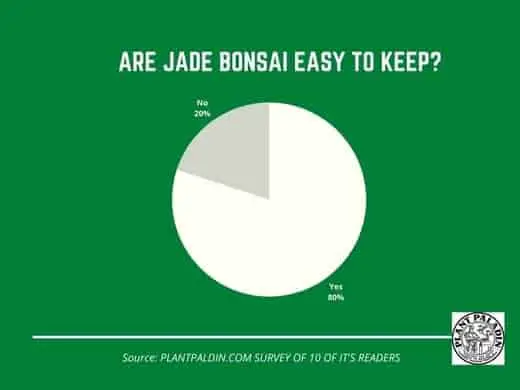
My top picks for the gear you will need!
So like I mentioned earlier, over the past three years of running PlantPaladin, hundreds of people have asked me for my recommendations on the best bonsai gear on the market.
Having spent thousands of dollars on bonsai items these past few years and tested at least 100 bonsai-specific products, I’ve listed my favorite products below – All of which I highly recommend and think you can get great value.
They can purchase directly by clicking the link to take them to Amazon.
Bonsai Tool Set: One of the significant challenges I’ve had is finding a toolset that was not only durable but didn’t break the bank. SOLIGT has recently developed a fantastic bonsai tool set that covers all the tools you need to trim, prune, and repot your trees. – You can grab it here.
Complete Bonsai Set: Many of you will want to grow your bonsai trees entirely from scratch, but finding the varicose seeds, pots, and other items in one place can be challenging. Leaves and Sole then have created a complete bonsai set that I’ve personally used that ticks all the boxes. You can grab it here.
Bonsai wire: The number of times I’ve run out of wire for my bonsai or purchased cheap bonsai wire that doesn’t do the job is embarrassing for me to admit. After a lot of trial and error, I found that using Hotop’s aluminum bonsai wire is one of the best options on the market. This can easily be used for both indoor and outdoor bonsai. You can grab it here.
This post was written by Fehed Nicass who has been passionate about bonsai for over 2 years. He currently resides in the UK and works in sales.
